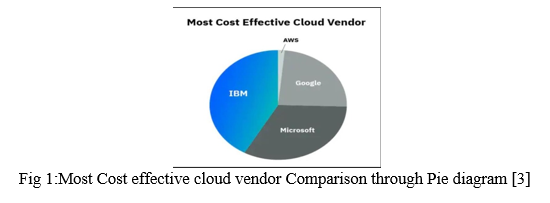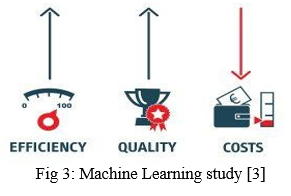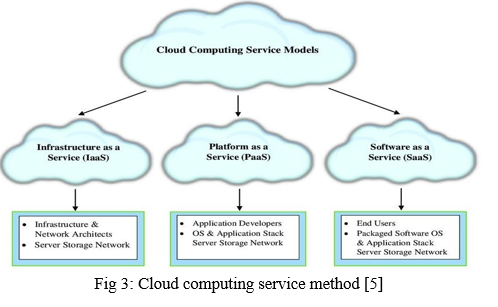Ijraset Journal For Research in Applied Science and Engineering Technology
- Home / Ijraset
- On This Page
- Abstract
- Introduction
- Conclusion
- References
- Copyright
Comparative Analysis of Cloud Computing Machine Learning - Azure vs. GCP vs. AWS
Authors: Gayatri Ghawade, Rujuta Shirke, Neha Kardekar, Prajwal Khadse, Prof. Ankush Patil
DOI Link: https://doi.org/10.22214/ijraset.2022.39967
Certificate: View Certificate
Abstract
The popularity and use of Cloud computing is growing rapidly. Many companies invest in the industry to use it for themselves or to provide it as a service to others. One of the consequences of cloud development is the emergence of various security issues in both the industry and consumer. One of the ways to protect the Cloud is to use Machine Learning (ML). ML techniques have been used in a variety of ways to prevent or detect attacks and security gaps in the Clouds. In this paper, we provide comparative analysis of cloud computing for ML, Azure, GCP, AWS methods and methods. We analyzed 63 relevant studies and the SLR results were divided into three main research categories: (i) different types of cloud security threats, (ii) ML strategies used, and (iii) operational outcomes. [3]
Introduction
I. INTRODUCTION
There are many cloud platforms that provide machine learning services. This article discusses a comparative analysis between these commonly used cloud platforms and its various features based on Machine Learning. There are a variety of features that are common in all of these forums while some are specially provided for specific venues alone. To be discussed here are Amazon AWS, Google Cloud, Microsoft Azure. Machine learning as a service (or MLaaS) refers to a variety of machine learning tools offered as services from cloud computing providers. Similar to cloud service models such as SaaS (software as a service) or PaaS (platform as a service), using machine learning as a service means gaining instant access to powerful online tools at no cost orthe skills needed to create them yourself. [3]
II. CLOUD
- Amazon Web Services (AWS): Amazon Web Services (AWS) is a widely used cloud computing platform thanks to a wide range of services including On-Demand computing, Internet of Things, media resources, and Machine Learning, to name a few. In particular, ML resources hosted by AWS can be supported by a beginner who wants to get his hands on the industry or who wants to incorporate some of the techniques into his application without much difficulty, for a professional ML level developer., train, and modify ML models but has limited resources available. AWS provides cloud-based models with just one click and the Integrated Development Center to build, train, test, and deploy models in the cloud. It has the most efficient, least expensive, and most advanced ML models to use. One of the major components of AWS's ML stack is its Amazon SageMaker. This comes in many ways such as Studio, IDE cloud build and training ML models, Autopilot, ML automated model for out-of-the-box user data, and JumpStart, an easy-to-use visual interface for models from the standard model library of ML. Apart from this, AWS also has specialized Computer Vision and Natural Language Processing services.
- Google Cloud: Google cloud is one of the top leaders in the cloud market and their MLaaS solutions are gaining popularity and a high level of daily adoption. They provide fully customizable services at the end of the machine learning environment. Google's "AI Platform" offers full-featured ML services for easy development, fast production time, and easy maintenance with highly trained and trained models.
- Microsoft Azure: Microsoft Azure is a set of cloud computing services offered by Microsoft. Azure AI is an Azure unit that provides services for building, customizing, training, feeding, and using Machine Learning models with minimal background experience. Azure AI Forum provides a fast and easy way to build, train and deploy machine learning models using Azure Machine Learning, Azure Databricks, and ONNX Runtime. Supports a variety of frameworks, applications, and platforms for computer hardware. Along with the options for creating customized models, Azure also provides ready-to-use information mining services using Azure Cognitive search to extract data from a large information corporation. In addition to pre-trained and customized solutions, Azure supports integrated machine learning solutions where it provides state-of-the-art machine.

A. Machine Learning
When integrated with the cloud, machine learning applications can be developed and expanded. "Smart cloud" refers to the integration of machine learning into clouds. While the cloud is widely used for computer, network,and storage, Cloud Machine Learning will dramatically expand your opportunities for both cloud and machine learning algorithms.
Today, many cloud providers that offer ML capabilities, including senior leaders in the cloud business - AWS, Google, and Microsoft - provide support for three types of speculation.
- Binary Prediction: This type of machine learning prediction works with "yes" or "no" answers. It is commonly used for fraud detection, search engines, and order processing, to name a few applications.
- Category Prediction: In this type of prediction, a set of information is identified and based on the information collected from it, the database is grouped under a particular category. For example, insurance companies use category forecasts to classify different types of claims.
- Price Prediction: This type of prediction looks at trends in large amounts of data through study models to show the quantity ratio of all possible outcomes. It is used by businesses to estimate how many units of product will be sold soon (e.g., next month). It enables them to adjust their production strategies more efficiently.
What are the benefits of learning from a cloud-based machine?
The following are the three main benefits of cloud learning:
a. Companies / businesses can use the cloud to test machine learning technology and grow as needed as projects become live and demand grows.
b. Companies that want to rent machine learning in their business but do not want to spend a lot of money can use cloud platforms for each payment method.
c. To access and use most ML features in the cloud, you do not need advanced Data Science skills.
B. Main Benefits Of Machine Learning
1. Cost Effective: The cloud operates on a per-pay basis basis. This avoids the need for businesses to engage in costly and expensive machine learning programs that will not be used on a daily basis. This is especially true for many businesses, as machine learning is used as a tool rather than the original method.

As AI or machine learning capabilities grow, a cloud payment system will become more useful, allowing businesses to save money. GPU power can be used without the need for expensive computer hardware. Machine learning in the cloud provides low cost data storage, thus improving system cost efficiency.
2. No Specialized Expertise is Required: Only 28% of firms have AI or machine learning, according to a Tech Pro study. Machine learning is becoming more popular, and your future prospects are promising. According to 42% of respondents, their IT team does not have the necessary skills to accept and support AI and machine learning. This indicates that there is a critical gap in knowledge and expertise. However, a cloud can help bridge the chasm. Companies should not have to worry about having a data science team when using the cloud. Performance features can be integrated with Google Cloud Platform, Microsoft Azure, and AWS without the need for in-depth or basic knowledge. Machine learning capabilities can be developed quickly using SDKs and APIs already provided. [6]
3. Cloud Computing: The word Cloud means Network or Internet. In other words, we can say that the cloud is something, which exists in a distant place. Clouds can provide services through public and private networks, i.e., WAN, LAN or VPN. Cloud Computing means cheating, fixing, and accessing hardware and software resources remotely. Provides online data storage, infrastructure, and application.
C. Basic Concept
There are certain services and models that run on the scenes that make the cloud computing processable and accessible to end users. The following are effective models of cloud computing:
- Shipping Models
- Service Models
- Utility Models: The type of access to the cloud, or where the cloud is, defined the application models. Public, private, mixed, and public access is four ways to reach cloud access.
a. Cloud Computing in the Public Sector: The public cloud makes systems and services available to anyone with an Internet connection. Because of its openness, the public cloud may be less secure.
b. Cloud Computing in Your Home: Within a business, a private cloud allows systems and services to be accessed. Because of its privacy, it is extremely secure.
c. Community Cloud Computing: A group of organizations can access systems and services through the public cloud.
d. Cloud Hybrid: A hybrid cloud is a combination of public and private clouds where important activities are hosted by a private cloud and non-essential activities are hosted by a public cloud.
D. Service Models
Service models support cloud computing. These can be divided into three types of service models:
- Infrastructure-like Service (IaaS) is a rental service (IaaS)
- Platform-as-a-Service (Platform-as-a-Service) (PaaS)
- Software -as-a-Service (SaaS) is a form of cloud computing (SaaS)
Anything-as-a-Service (XaaS), which includes Network-as-a-Service, Business-as-a- Service, Identity-as-a-Service, Database-as-a-Service, and Strategy-as- ia -Service, is another service paradigm. The most basic level of service is Infrastructure-like Service (IaaS). As shown in the diagram, each service model inherits security and management methods from the basic mode.

E. Features of Cloud Computing
- Large Network Access: Because cloud computing is fully web-based, it can be accessed at any time and anywhere.
- Combining Resources: Most employers can share a set of resources through a cloud computer. One outstanding example of hardware, website, and basic infrastructure can be shared.
- Quick Elasticity: At any time, you can easily measure resources directly or horizontally. The ability of resources to increase or decrease in response to a changing need is called resource rating.
- Advantages: Cloud Computing has many advantages. Some of these are listed below
a. One can access apps like apps, online.
b. One can cheat and configure online applications at any time.
c. You do not need to install software to access or control the cloud system.
d. Cloud Computing provides online and feed development tools, a system operating system space with a PaaS model.
e. Cloud services are available on the network in a way that provides independent platform access to any type of client.
f. Cloud Computing provides the service you need. The services can be used without consulting a cloud service provider.
g. Cloud Computing is very expensive because it is very efficient and fully utilized. It just needs an internet connection
h. Cloud Computing provides load balancing which makes it very reliable.
|
AWS |
Azure |
GCP Tool |
|
Has Elastic compute cloud ec2,it is basically used to create instances and it provide secure reliable compute capacity in the cloud. |
Azure vm gives you the flexibility of virtual zing without having to buy and maintain physical hardware that run your application. |
GCP offer compute engine it is the compute services that let you create and run virtual machine on Google infrastructure. |
|
Amazon S3 object storage it is basically used to store any kind of file in the cloud. |
Azure Blob Storage |
Cloud Storage |
|
Networking is network type infrastructure in which some or all of an organization network capabilities and resources are hosted in aws it is Amazon vpc(virtual private network cloud). |
Azure virtual Network |
Cloud virtual Network |
|
AWS started in year 2006. |
Azure started services in year 2010. |
GCP launched in year 2008. |
|
AWS is friendly with the open source model from the beginning. |
Azure has not so good relationship with the open source community. |
GCP offer managed open source services operated that are tightly integrated into google cloud. |
|
AWS allows user to easily integrate services like Amazon ec2,amazon s3 |
Azure allows users to integrate services like Azure VM ,Azure App Services. |
GCP allows users to integrate services like Compute Engine, Cloud Storage. Cloud sql |
|
Integrate an external software or a third party software like Artifactory.
|
Azure Artifacts used to manage the packages (Nuget ,Maven,etc).
|
Artifact Registry is a single place to manage container images and language packages (Maven and npm).
|
|
NETFLIX, BBC, FACEBOOK use AWS |
Adobe, HP ,Sumsung use Azure |
PayPAl, Spotify, Toyota use GCP |
Conclusion
In this paper we discuss the uses of cloud computing with machine learning . There are many benefits of cloud computing and we have discuss Azure, GCP, Amazon .Cloud is use to store data on server and to use that data we are using machine learning code. We can store data in database or hard disk but if huge amount of data is present at that time what to do ? This problem is solved by cloud, it provide quickly access ,security, cost saving ,Flexibility ,Backup and many more.
References
[1] Azure: GokaySaldamli, Doshi Nishit, Gadapa Vishal, Parikh Jainish, Patel Mihir, LeventErtaul, \"Analysis of Machine Learning as a Service\", The 17th International Conference on Grid, Cloud, & Cluster Computing, GCC\'21: July 26-29, 2021, US [2] AWS VS Azure VS Google Cloud — Comparative Analysis Of Cloud Platforms Machine Learning OjashShrestha Aug 27,2021linkedin.com/pulse/aws-vs-azure-google-cloud-comparative-analysis-machine-ojash-shrestha [3] Machine Learning : Scott Pletchersep 2, 2021 acloudguru.com/blog/engineering/what-is-machine-learning-as-a-service-mlaas [4] Machine Learning:Author :GeorgianMay 21, 2020upgrad.com/blog/top-applications-of-machine- learning-algorithms-using-cloud Comparing Google cloud Platform, AWS and Azure: medium.com/georgian-impact-blog/comparing-google-cloud-platform-aws-and-azure-d4a52a3adbd2 [5] Cloud Computing: tutorialspoint.com/cloud_computing/cloud_computing_overview.htm [6] Key Benefits of machine learning in cloud computing:GUY HUMMEL AND JEREMY COOKAUGUST 23, 2018 cloudacademy.com/blog/what-are-the-benefits-of-machine-learning-in-the-cloud
Copyright
Copyright © 2022 Gayatri Ghawade, Rujuta Shirke, Neha Kardekar, Prajwal Khadse, Prof. Ankush Patil. This is an open access article distributed under the Creative Commons Attribution License, which permits unrestricted use, distribution, and reproduction in any medium, provided the original work is properly cited.

Download Paper
Paper Id : IJRASET39967
Publish Date : 2022-01-16
ISSN : 2321-9653
Publisher Name : IJRASET
DOI Link : Click Here
 Submit Paper Online
Submit Paper Online

